
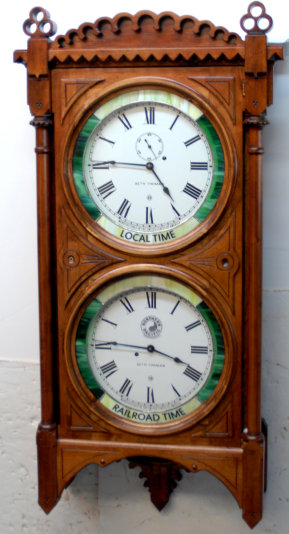
34. $1800
Ansonia Clock Co. “General”, ca 1914. We do not get very many
General’s, thankfully, because we do not have places to hang clocks this large. The walnut case is 68” high and 28” wide across the
top. This case has all the carved ornaments and they are original. The top ornament has been (hit) broken and glued back in place.
The clock has two good glasses, three original hands, and the 18” dial pan with the very good original painted dial. The dial is very
nice and clean, and has no scratches but does have some small chips on the outside edge, around the screws, and the arbors. The brass
weights are original, same with the brass pendulum bob and wood stick, and the beat scale. The 8-day double weight, time only movement
is signed and running. The Generals we have seen and sold in the past are usually oak and have dings and bruises around the edges
because they are too large for one person to carry and hang, but the same folks who do not stop and ask directions do not stop and
ask for help hanging these huge clocks, therefore the dings. This one may have been owned by a female for it does not have those problems.
My picture leaves a little to be desired, but again, I could not move it by myself to a good place to photograph. Ly-Ansonia, pages
180-181. $2500-$3500.
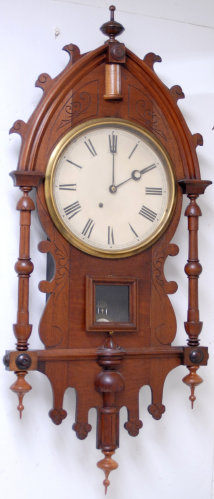
35. $1750
George A. Jones & Co. Bristol, Conn. and New York City. This
rare wall clock is the “Fritz” model, ca 1865-1870. Jones is not as well known as many clockmakers but he for sure made some very
unusual, very nice, and now very rare clocks. This mahogany case is 46 inches high and appears to be all original with the possible
exception of the three finials on the bottom. The pendulum is hung thru the small glass door. I could not hang the pendulum for the
picture but believe me the time only eight-day movement is running. You can only get one hand thru the door to hang the pendulum and
after a while I gave up. The brass bezel is hinged at the top, dial is excellent, appears old, but on the other hand too nice to be
original. No label, but there is evidence on the back it probably had a label. $2000-$2500.
33. $1000
Seth Thomas Clock Co. a rare model, “Office Calendar No. 5”.
The clock is a reproduction and is very nice, clean, polished, and complete. Obviously some restoration has been done to the clock.
This reproduction No. 5 was transformed into a railroad clock with two time dials, new trim around to the outer rims of both glasses,
and of course the calendar movement was removed. The ornate trim top and bottom are identical to the original clocks so we assume
all are correct on our case. A special key opens the little door on the base. That door has a glass for viewing the pendulum ball.
The 8-day movement is running and operating both time dials. There are two large iron weights and a brass pendulum with wood stick.
We probably have sold fewer than a half dozen No. 5 double dials over the years, of course none like this one, the last two originals
brought over $10,000 plus the premium. Ly-Calendar #606; Ly-Seth Thomas, page 94. $7500-$9000.
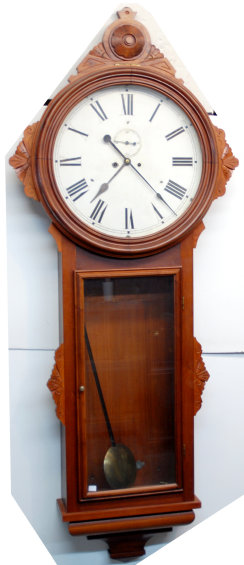

36. $1200
E. Howard & Co., Boston, Mass. “Bicentennial” reissued banjo,
ca 1978. Howard reissued this banjo model to commemorate 200 years of the US government, 1776-1976. The glasses are inscribed and
there is a factory label inside indicating this is No. 115 of their model “95B-1”. It is almost a Howard No. 5 banjo except for the
addition of the tail and the special finial on top. The case is 42 inches high, rosewood stained, near new, cannot find any reason
not to call it new. It may have never been hung on the wall. The case is also stamped “115”. I did not remove the dial but the previous
owner says the movement is signed, the weight is correct and it is in running condition. $1200-$1500.
32. $800
New Haven Clock Co. extremely rare calendar clock, “Cabinet No.
4 With Perpetual Calendar”, ca 1885. Researchers have been unable to come up with any information on this unusual calendar mechanism.
The calendar dial is original but shows some age even though it is behind glass that is never removed. I think it is because it is
paper where the time dial is metal. The perpetual calendar shows the month, and the day of the month. The time dial is also near perfect.
I cannot say for sure it has been repainted at some time. The movements are clean and in good operating condition. The time movement
runs 8-days and strikes hours on a bell positioned in the base of the case. Access to the pendulum is thru the base. The 19” high
case is made of quarter sawn oak and is exceptionally clean and beautifully polished. It is complete and all original. The only
other one I have sold was in 2012, went for over $2000. Ly-Calendar, page 198. $1000-$1500.

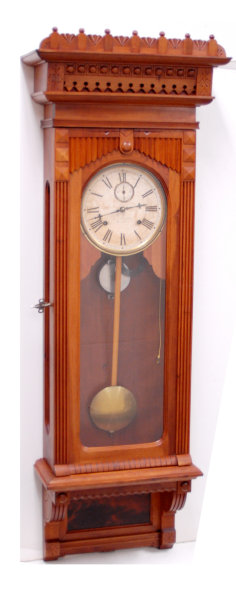
37. $950
Wm. L. Gilbert Clock Co. “No. 11 Regulator”, ca 1891. We have
sold several of this model over the years always with great success for it has always been a popular clock. In many ways this clock
may be the finest of the lot. The 50” high case is made of solid cherry and has been rubbed and rubbed, until it looks like a pricey
piece of antique furniture. All the brass has been polished, movement gone thru and serviced and overall is in tip top condition.
Of course it is almost 120 years old so you can surely find an age spot, bump, or bruise, somewhere and I know some of you collectors
won’t like it because it is so clean and polished. The three glasses are held with original putty or some genius has put new putty
around them. The original paper dial is signed, aged and darkened, but all there and certainly acceptable. All the wood parts look
to be original, no repairs or new parts visible. Some of the wood work is very detailed and most unusual. Door lock on the side, old
winding crank, pair of correct and original brass weights and brass pendulum with the original wood stick. I did not hang the weights
for the picture. The movement is 8-day, time and strike, mounted to a large iron back plate, and is powered by two brass weights that
descend each side of the case. The weight cords are wound around one spool on the bottom of the movement, then the cords go up to
the top, each side of the case, over spools, and then come down the sides. The strike is spring operated, not weight. Ly-Gilbert,
page 135. $1000-$1500.

38. $800
Seth Thomas Clock Co. “Office Calendar No. 2”, ca 1875. A very
large rosewood veneered case standing 42 ˝ inches tall, in very good condition. The case has very little veneer damage, mainly a chip
or two on the top and base which is very common on these large clocks that are hard to move about by one person. The glasses are good
and there is an excellent large black label on the back of the door. The movements, dials, weight, and pendulum bob, are correct or
original for this type clock. The painted dials are 14.5” in diameter, top dial with very little flaking. The label is signed, “Seth
Thomas Clock Company, Thomaston, Conn.”. The time only movement is 8-day, powered by one wafer weight that descends a weight chute
on the right side of the case. The calendar movement is perpetual. The door lock on the case side requires a male ended key to operate
the lock. None came with the clock and I don’t have one. They can be easily made on a lathe or with a file. A beautiful and large
clock.. Ly-Calendar, page 247. $1000-$1500.

39. $450
New Haven Clock Co. “Columbia”, ca 1911. A rare cherry cased 30
day hanging clock that was seldom made and a model we have not seen before. It is a long, thin clock, 48 ˝ inches tall, and only 14”
wide. At first glance it appears to be very plain, but actually there is a lot of fine wood work top to bottom. There are three long
glasses, some carvings on the door framing around the dial and on the tail, and the top is removable. The clock appears to be
complete and all original. The case has been polished/rubbed, making it suitable for any home. Signed dial, three hands, brass bob,
wood stick, brass beat scale, are all correct and most surely original to the case. The movement runs 30 days on one winding. It is
surely a better looking, more regal clock, than the books make it out to be. Ly-New Haven #521. $500-$750.
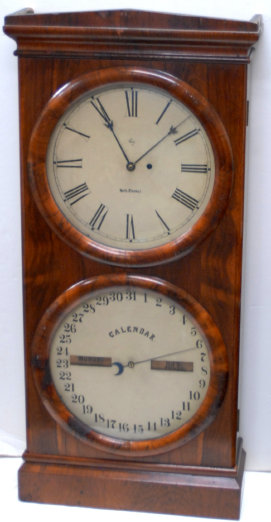

40. $1000
Seth Thomas Clock Co. “Regulator No. 1”, ca 1860-1865. Complete black and gold label covering the weight chute panel, says in part, “Manufactured by Seth Thomas Clock Co. Thomaston, Conn.”. Rosewood veneered case is 34” high, has good veneer all over but undoubtedly has a nick or two somewhere. I see no real problems with the clock. The hands, glasses, weight, pendulum ball and stick, all appear to be original. Someone has polished the brass pendulum ball until it is mostly a copper color. You can have brass put back on them if you choose. The paper beat scale in the base, separate from the label, if there was one it is pretty well wiped out. Both doors lock with a hook on the side. The movement is the early type, rectangular, and the weight drops down the center of the case behind the sliding label board, like the later No. 2 regulators. This nice very early clock is running, and is very good looking. Ly-Seth Thomas, pages 269-271. $1000-$1500.
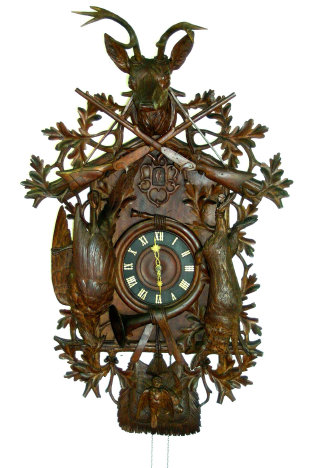
41. $3000
German Black Forest cuckoo clock, ca 1890. The linden wood heavily
carved case is 48 inches tall, including the antlers, 45 inches with antlers removed, 24 inches wide and 10 inches deep. The moose
deer head on top is quality carved with good detail as are the other carvings. The 8 ˝ inch dial has good numbers and fancy original
bone hands. It has old pine cone weights and old 21-inch-long pendulum with two carved leaves for the pendulum bob. There is also
a good hand-carved bird. The nicely hand carved wood antlers are not old but were made correctly. There are a few small cracks repaired
with some leaf tips repaired. The overall condition is very good for a clock this old and this size. It has a one-day time and strike
movement that is running. It is not often we get an old quality Black Forest clock of this size offered for sale. I looked back thru
old auction catalogs and saw that we used to sell one or two dozen nice cuckoo clocks every auction, but these days we are lucky to
have one for sale. A good reference book is “Black Forest Clocks” by Rick Ortenburger. I sold this same clock for over $5000 several
years ago. $3000-$4000.